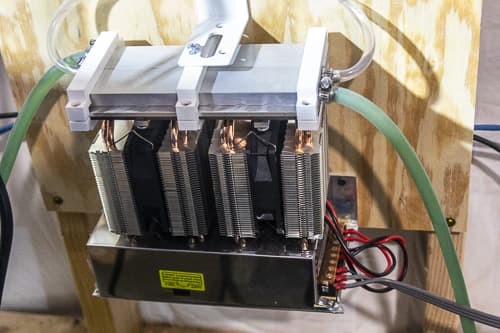With regards to other chiller ideas- you really need to know the load wattage and calculate for BTU/hr. It is a pretty high number. An aquarium chiller is probably nowhere near enough.
It has to have the BTU/hr. Otherwise the temp will outrun the chiller on long full-power runs and typically just keeps rising every minute. The tube performance will fall off with higher temps.
“Can I run it through a radiator first on the return path to bring it to ambient, then add a small chiller after that?” Well, the prob is, if you have a 25C room and need to run the tube at 20C, the only way this works is the tube has to have >25C water coming out of the tube so the radiator can work. We already said we wanted the tube at 20C but this does not allow us to do that.
“Could I run the water really slow so the chiller gets it 20C in but gets >25C on the tube outlet?” That would defeat the point of chilling. The bore is now too warm on the exit side, AND has a temp gradient down its length (bad).
I’m not sure how many watts of heat a DC-excited glass 100W tube makes. You could measure the wall current for the power supply in actual constant full-power test, deduct 100W for the actual tube output, and the rest has to be lost heat- but, SOME will be in the power supply and is not a cooling load. Maybe 15%? 25%?
If you knew tube voltage and current, you could calc it, but you would have to measure the actual (not datasheet) tube voltage directly which requires a special meter and it’s kinda dangerous.
Anyhow, spitballing, maybe a 100W tube is 10% efficient, takes in 1KW. 900W needs to be removed. 1 kW = 3412.142 BTU/hr, so you need 3070 BTU/hr. A 1/10hp aquarium chiller is 1000 BTU/hr, it will lose- and, again, once it is in a cooling deficit, the way refrigeration works, it doesn’t transfer heat much faster from a hot “cold” side, it will keep rising. It could go to like 40C.
The coolant should not be within 10 deg of the wet bulb temperature in the room. This guarantees condensation will not occur, which can damage the optics.
Peltiers would be tough. The performance drops off rapidly with delta-T from the two faces and running anywhere near their rating:
Note that 20C water and 25C ambient is not the final delta-T. The water block has to a bit cooler than the water for heat to transfer. The drop on the hot side, to air, is much higher. If this transferred EXCEPTIONALLY well, that might be a 15C-20C delta-T total (water 5C below ambient, plus the two combined thermal resistances of the sides). If you ran the Peltier at the rated power, your COP is only 0.5 (need 1800W of electrical power to the Peltier and have to reject 2700W). Well, that’s gone into the weeds, this is SO MUCH heat and… well, no practical size of heatsink is going to give a delta-T of 15C at 2700W.
You’d need an array of Peltiers. If we shoot for a COP of 1.75, with REALLY good sinks, they’d have to be run at 20% of Imax. You’d need 8.57x “60W” 40mm/40mm Peltiers run at 20% of max current.
At this point 1400W is being dumped out of those sinks into the air, basically the output of a hair dryer. But these numbers ONLY work if the delta-T is really, really low. Like the output air can only be a few deg C over the room. That would require a massive CFM of airflow across the sinks to keep the exhaust flow minimally above ambient.
And that’s unrealistic, actually. This is going to have a higher delta-T, like 25C. Shoot for a COP of 0.75, 20x “60W” 40mmx40mm, 2100W of heat through the heatsinks. They’d have to be really good sinks.

